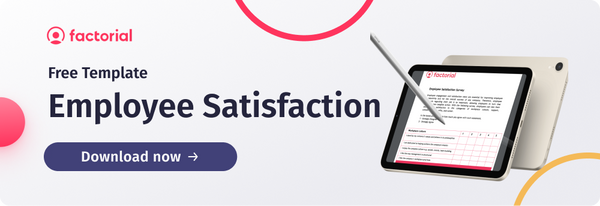The latest statistics from the Employment Tribunal have revealed that unfair dismissal claims, including those relating to constructive dismissal, have increased by a whopping 51% from the previous year.
Experts are putting much of this down to Covid-related delays and a peak in complaints rooted in the furlough scheme. However, some statisticians are blaming the cost-of-living crisis and nationwide employee unrest, and believe that these factors could lead to a further increase in claims this year.
With constructive dismissal cases rising, it’s even more important for employers to understand the grounds for this type of resignation and how best to avoid it.
- What is Constructive Dismissal?
- Constructive Dismissal Cases
- Constructive Dismissal Compensation
- How to Prove Constructive Dismissal
- Criteria for Making a Constructive Dismissal
- How to Avoid Constructive Dismissals
- ✅ Try Factorial Free for 14 Days
What is Constructive Dismissal?
A ‘constructive dismissal’ is essentially a type of resignation rather than a dismissal. An employee can claim for this on the grounds that their employer has broken their employment contract in some way. For this reason, it’s also known as a ‘constructive unfair dismissal’ in the legal world; the employee has been treated unfairly and feels that leaving is the only option. But what constitutes constructive dismissal?
Examples of constructive dismissal include:
- Being underpaid continuously for a reason unrelated to the employees’ actions.
- Racism, sexism or other types of discrimination.
- Changing shift patterns in ways that aren’t outlined in the contract.
- Being forced to work in an unsafe working environment.
- Bullying or intimidating behaviour.
There are of course many other incidents that could be considered grounds for constructive dismissal. Regardless of the context, the Employment Rights Act 1996 states that an employee must prove that a serious breach of contract has occurred and that this breach is connected to their resignation. The resignation must also be effective immediately as staying could be viewed as acceptance of the employer’s behaviour.
Bear in mind that the grounds for constructive dismissal are only valid if an employee has worked for the organisation for a minimum of 2 years.
Constructive Dismissal Cases
Constructive dismissal cases are plentiful, yet successful constructive dismissal claims are few and far between. It can be incredibly difficult to prove that the legal grounds have been met, which is why so few employees win their cases once they reach Employment Tribunal. According to Monaco Solicitors, approximately 5% of claims successfully win – and earn compensation.
Reflecting on these real constructive dismissal cases from recent years is a useful way to understand what stands up at tribunals. However, they also highlight how difficult it can be to win, even when it seems that the employee holds all the cards.
Craig vs. Abellio
An employee had been absent due to sickness but their sick pay was miscalculated due to mistakes made by the employer, who owed over £6,000. The employer missed the deadline to pay causing the employee to resign immediately and cite constructive dismissal. The employment tribunal (ET) found the employer’s mistake to be genuine, until the employment appeal tribunal (EAT) requested the case be reviewed again. The employee won the case on this appeal.
Mr Parbhjot Singh v Metroline West Limited
Mr Singh, the employee, took sick leave just after being asked to attend a disciplinary meeting. The employer ordered an occupational health appointment to assess the validity of the illness claims. They didn’t deduce that it was a lie but the employer wasn’t convinced and chose to pay him statutory sick pay rather than contractual sick pay, leading Mr Singh to claim constructive dismissal. Initially, the breach of contract was not found to be enough for the claim to win, however the EAT rejected this and ruled that he hadn’t received pay he was entitled to.
Adams v Charles Zub Associates Ltd
Adams, the employee, didn’t receive his previous month’s pay leading him to claim constructive dismissal. This seems like an open and shut case; an employee not getting paid surely equals payout, right? Nope. As the employer didn’t intentionally withhold their salary and Adams knew about the company’s financial circumstances beforehand, the case was dismissed.

Constructive Dismissal Compensation
Due to the low success rate of cases, many will opt to avoid an employment tribunal altogether and will instead opt for an out-of-court settlement and a constructive dismissal payout.
For those that do succeed at an employment tribunal, they will likely be offered more generous constructive dismissal compensation. This sum is made up of two parts:
- Basic Award
The max amount that can be granted as a Basic Award is £17,130. To get to this number, the court will multiply: (claimant’s length of continuous service up to 20yrs) x (one week/one and half weeks/half a week’s pay, depending on age and up to the maximum of £571). This logic may differ if you were found to have conducted yourself poorly or were made redundant.
Use the Landau Law calculator to find a more accurate estimate.
- Compensatory Award
Generally, this makes up the larger proportion of the total constructive dismissal payout and is harder to estimate or calculate. According to the Employment Rights Act, this is “such amount as the Tribunal considers just and equitable in all the circumstances having regard to the loss sustained by the complainant in consequence of the dismissal insofar as that loss is attributable to action taken by the employer.”
How to Prove Constructive Dismissal
Constructive dismissal claims are made up of two parts. A claimant must prove both of these are true in order to prove constructive dismissal was valid.
1. Serious breach of employment contract has occurred
This applies if the employer has broken either a written, literal term within the contract or an implicit term relating to mutual trust. The latter is much rarer but can happen as was seen in the case of Malik v. Bank of Credit and Mahmud v. Bank of Credit. It can be either one occasion or a build-up of multiple incidents, as long as the matter is severe.
2. Resignation was triggered by this breach
The key to this is resigning immediately after the incident takes place. Any delay could be perceived as acceptance of that behaviour, making the causal effect more difficult to prove! The more time that passes, the higher the likelihood that the reason for resignation was unrelated.
Criteria for Making a Constructive Dismissal
Not everyone is legally entitled to claim constructive dismissal. There are certain criteria an individual must meet before filing, such as:
- Holding the employment status ‘employee’ (which may exclude agency workers).
- Having worked for the employer in question for at least 2 years (including statutory notice period).
You can make a claim if you’ve met both of these points, but it must be within 3 months minus a day from either the final day of your notice period or the day you resigned if you didn’t work a notice period.
Sometimes, an incident can occur within the first two years of working for an organisation. It’s unlikely you’ll be able to make a constructive dismissal claim in these instances, but you might be able to if your reasoning is rooted in:
- Discrimination (e.g. pregnancy, race, ethnicity, gender, disabilities, sexuality, age).
-
Something that is ‘automatically unfair’, e.g. the trigger was unfair treatment rooted in you:
- Being pregnant or on maternity leave.
- Making a request for minimum wage pay or another legal employment right.
- Acting in the interests of employee health and safety.
- Whistleblowing.
- Refusing Sunday work (in a shop).
- Carrying out trade union activities.
How to Avoid Constructive Dismissal
When it comes to constructive dismissals, prevention is the best cure. It’s cheaper and more effective to learn how to avoid them rather than how to deal with them. Not only is this better for employee morale, it’s better for the reputation of your employer brand and the long-term success of your business.
To avoid these altogether, you should aim to:
1. Construct an honest and open company culture
We’ve put this top of the list because it’s inarguably the most important. Although company culture might feel intangible at times, it is what the foundations for all of the other steps. Think of it as the invisible architecture of your organisation. If employees feel that transparency and honesty are highly valued, they will be more trusting of their employer and will feel more comfortable reporting any injustices before they reach the extreme stage of resignation.
2. Create clear channels for employees to voice concerns
Having a culture of honesty can get you so far. Logistically, you also need easy and accessible pathways for employees to report their worries. It’s all good and well telling them to feel comfortable expressing concerns, but if there’s no way to do this then they’ll feel there’s no choice but to leave and report their problems elsewhere. Ensure employees know who to contact and how to do it. Consider sharing a report form template that they can fill in so that you collate all of the necessary details to deal with the root issue.
3. Train managers to deal with these reports
So, now you’ve encouraged your employees to voice their concerns to a certain individual through an established channel. What then? Your managers need to be trained in responding to these incidents in a way that will neutralise tension rather than inflame it. If you don’t have the resources to train managers internally on dealing with conflict, take a look on websites like SkillSoft that offer courses in soft skills for managers.
4. Publish policies on unfair treatment of workers
An incident report should put actions into motion. To ensure fairness across the board, these actions and processes should be outlined within your company policy. What are the next steps? How will the report be validated? What is the consequence for the person a report is being made against? How will reports be escalated and who to? What is the timeframe? These are all questions that your policy should answer.
Create policies and share them with your workforce using Factorials all-in-one HR software. Our internal communications and events tool allows you to write announcements and share them with your employees with just a few clicks. These memos can be company-wide or targeted at specific groups, so you can notify different employees and teams about company policies most relevant to them!
From the same place, you can use our Employee Net Promoter Score (eNPS) tool to measure the satisfaction of your staff using surveys. Respondents are categorised into detractors, passives and promoters, giving you insight into how your employees are feeling about the company and their management. Having visibility over general sentiment will help to pinpoint any problem areas and nip them in the bud before they reach constructive dismissal territory.
✅ Give it a try for free for 14 days and see how Factorial can help you improve your company culture and the employee wellbeing.



